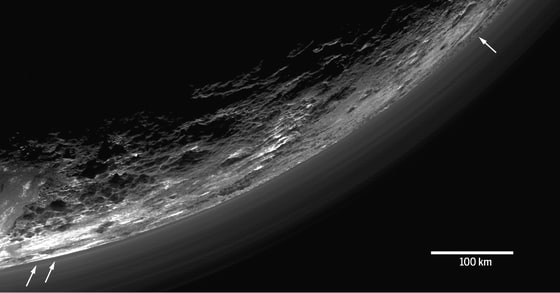Pluto, known for more than eight decades as just a faint, fuzzy and faraway point of light, is shaping up to be one of the most complex and diverse worlds in the solar system.
Pluto's frigid surface varies tremendously from place to place, featuring provinces dominated by different types of ices — methane in one place, nitrogen in another and water in yet another, newly analyzed photos and measurements from NASA's New Horizons mission reveal.
"I don't know any other place in the entirety of the outer solar system where you see anything like this," said New Horizons principal investigator Alan Stern, who's based at the Southwest Research Institute in Boulder, Colorado. "The closest analogy is the Earth, where we see water-rich surfaces and rock-rich surfaces that are completely different."
That's just one of the new Pluto results, which are presented in a set of five New Horizons papers published online Thursday in the journal Science. The five studies paint the Pluto system in sharp detail, shedding new light on the dwarf planet's composition, geology and evolution over the past 4.6 billion years.
Last July, New Horizons performed the first-ever flyby of Pluto, coming within just 7,800 miles (12,550 km) of its surface. The spacecraft saw towering water-ice mountains; flowing nitrogen-ice glaciers; pebbly "snakeskin" terrain; a vast, crater-free plain known as Sputnik Planum; and many other features that scientists are still trying to figure out.
"I don't know any other place in the entirety of the outer solar system where you see anything like this."
One of the new papers dives deeply into the geology of these features, revealing new insights about their possible origin and evolution. The 620-mile-wide (1,000 km), nitrogen-ice-dominated Sputnik Planum, for example, apparently sits atop a huge and ancient impact basin, mission scientists say.
Sputnik Planum is smooth and pristine, bearing no impact scars. This shows that the region was resurfaced extremely recently — 10 million years ago at most, and possibly much more recently than that, researchers said.
Related: Why NASA's New Horizons Mission is Such a Big Deal
But other parts of Pluto harbor lots of visible craters, and some regions have a middling number, suggesting that the dwarf planet has been geologically active on a large scale over its entire history.
This finding came as a big surprise when it was first announced last year. Earth remains geologically active because it has a hot, molten core. Some icy satellites, such as Saturn's moon Enceladus and Jupiter's moon Europa, also harbor substantial internal heat, which is generated by the powerful gravitational tug of their giant parent planets. But something else is likely happening at Pluto.
"I think we have to rethink our whole understanding of geophysics — how you keep small planets active over time," Stern said.
Stern isn't sure what exactly is going on, but he has a favorite hypothesis: that a subsurface Pluto ocean has been slowly freezing over the eons.
"As it freezes, it releases latent heat," he said. "It may be the freezing of this ocean that's powering all this geology."
The new geology paper also discusses and interprets a number of other Pluto features, such as the huge, dark-red Cthulhu Regio — which appears to owe its color to hefty concentrations of tholins, complex organic molecules that drifted down out of the dwarf planet's atmosphere — and the towering peaks Wright Mons and Piccard Mons.
One of the other new Science papers maps out the distribution of various ices across Pluto's surface. This material — primarily frozen methane, nitrogen, carbon monoxide and water — is deposited in a curiously distinct way, researchers found; some Pluto provinces are dominated by nitrogen ice, others by methane and so on.
"I think we have to rethink our whole understanding of geophysics — how you keep small planets active over time."
This pattern suggests that volatile material (nitrogen, methane and carbon monoxide) is being moved around by sublimation, condensation and glacial flows on both seasonal and geological time scales, the researchers said.
The five papers, which you can read for free on Science's website, don't represent New Horizons' last word on Pluto — far from it. For example, mission team members plan to present more new results next week at the 47th Lunar and Planetary Science Conference in The Woodlands, Texas.
And there's still a lot of flyby data left to analyze. New Horizons has beamed only half of the close-encounter images and measurements back to mission control, Stern said; the entire treasure trove likely won't be on the ground until October.
Pluto was discovered in 1930 by American astronomer Clyde Tombaugh. The dwarf planet remained largely mysterious for many years thereafter, because it lies so far from Earth.
Pluto orbits in the Kuiper Belt, the icy realm beyond Neptune, at an average distance from the sun of about 40 astronomical units (AU). (One AU is the distance from the Earth to the sun — about 93 million miles, or 150 million kilometers.) That's so remote that even the best photo by NASA's famous Hubble Space Telescope portrays the dwarf planet as a mere blur of pixels.
